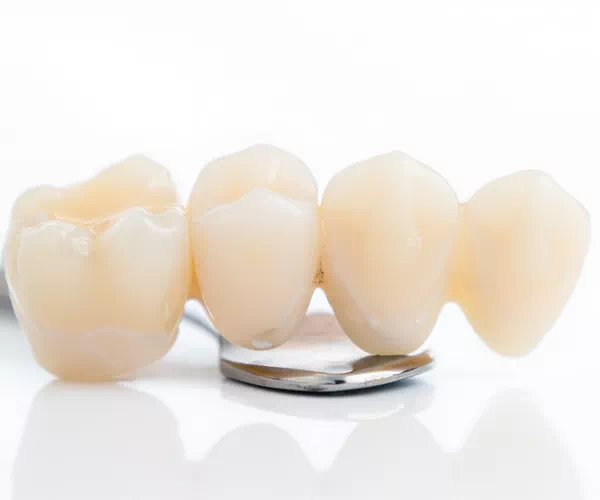Dental Bridges in Lorton VA
Dental bridges, a time-tested solution in restorative dentistry, not only fill the gap left by missing teeth, but also restore the harmony of the teeth. Dental bridges act as a decisive intervention, preventing these complications and restoring both form and function.

What are Dental Bridges in Lorton VA?

Dental Bridges typically consist of a pontic—an artificial tooth that fills the gap—attached to two abutment teeth, the abutment posts on either side. These abutment teeth are prepared to accept crowns, which act as secure supports for the bridge.
Material choices range from durable porcelain fused to metal to the natural aesthetics of all-ceramic bridges. The choice depends on factors such as the location of the missing tooth, the chewing forces involved, and the patient’s aesthetic preferences.
At our clinic, we offer types of dental bridges
- Traditional Bridges:
These are secured with crowns on the teeth on either side of the missing tooth. - Cantilever Bridges:
These are used when there is only one adjacent tooth to support the bridge. - Maryland Bridges:
Also known as resin-bonded bridges, consist of a pontic supported by metal or porcelain wings that are bonded to the adjacent teeth, requiring minimal preparation of the abutment teeth. - Implant-Supported Bridges:
These are securely fixed with dental implants for maximum strength and stability.
What are benefits of dental bridges?

- Dental bridges allow you to restore the aesthetics of your smile. Gaps in your teeth can negatively affect your appearance, causing embarrassment and self-doubt. A bridge fills these gaps, returning your smile to its original attractiveness and improving your overall facial perception.
- Bridges restore the functionality of your teeth. Missing teeth make it difficult to chew food, which can lead to digestive problems. A bridge allows you to chew food properly, improving your digestion and overall health. In addition, restoring your teeth prevents adjacent teeth from shifting towards the gap, which can lead to malocclusion and other dental problems.
- Installing a dental bridge is a relatively quick and painless procedure. In most cases, installing a bridge requires only a few visits to the dentist. The procedure does not require complex surgery, making it less invasive than other dental restoration methods, such as implantation.
- Dental bridges are a relatively affordable solution compared to other methods of prosthetics. The cost of a bridge is usually lower than the cost of an implant, which makes it more accessible to a wider range of patients.
Disadvantages of Dental Bridges
However, it is worth noting that dental bridges also have some disadvantages. One of them is the need to grind down the supporting teeth that serve as support for the bridge. This can lead to weakening of these teeth and an increased risk of developing caries.
In addition, the service life of dental bridges is limited and averages 10-15 years, after which they may need to be replaced.
Despite these disadvantages, dental bridges remain a popular and effective solution for restoring the dentition, offering patients a number of benefits, including restoration of aesthetics, functionality and affordable cost.
What to Expect During Your Dental Bridge Procedure?
The process of getting a dental bridge typically unfolds over several visits.
- During the first visit, the abutment teeth are carefully prepared, including removing a small amount of enamel to accommodate the crowns. Precise impressions are then taken, which serve as a blueprint for the dental lab to fabricate the bridge. A temporary bridge is often placed to protect the prepared abutment teeth and maintain aesthetics until the final bridge is ready.
- At the next appointment, the temporary bridge is removed and the permanent bridge is carefully fitted and adjusted. The dentist carefully ensures a comfortable fit, proper bite alignment, and a natural appearance. Once satisfied, the bridge is cemented into place, providing a strong, long-lasting restoration.
Are you unable to decide if you need a dental bridge?
Book an Appointment Today

The specialists of the Lorton Dentist will provide a detailed consultation and offer the best solution for installing dental bridges taking into account your individual characteristics.
Deciding to get a dental bridge is a step towards a healthier, more confident self, allowing you to smile, speak, and eat with ease.
You can contact the practice online or call the number provided to schedule an appointment.
Caring for Dental Bridges
Maintaining a dental bridge requires diligent oral hygiene. Regular brushing and flossing are essential to prevent plaque buildup and keep the abutment teeth healthy.
Specialized floss or interdental brushes can make it easier to clean under the bridge and around the supporting teeth.
Regular dental checkups are also crucial to monitor the condition of the bridge and catch any potential problems early.
FAQ
Is it possible to attach a bridge structure if there is only one supporting tooth?
In some cases, this is feasible. We are talking about cantilever bridge prostheses, where fixation occurs only on one side. The choice of such a prosthesis is determined by the specific clinical picture. For example, if the patient does not have a fifth tooth, the sixth tooth can serve as a support for the prosthesis. Due to its developed root system and significant size, the sixth tooth is able to withstand the load usually placed on the fifth. It is important to note that the installation of cantilever bridges on the sixth and seventh teeth is not practiced, since they are not designed to perform a full chewing function.
How long do bridges last?
From ten to fifteen years.
Is it possible to do without depulpation?
Yes, if the supporting teeth are healthy.
